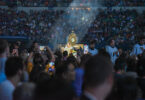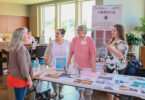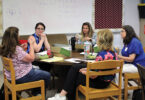by Jill Ragar Esfeld
Special to The Leaven
There’s no mystery to the Vittle Van. It is exactly what it claims to be — a van filled with vittles.
But each week, when it goes into the most forsaken parts of the inner city, the Vittle Van delivers much more than food.
And that’s why the volunteers who ride along and hand out meals to the homeless call themselves Hope in the Streets.
“There are a lot of great organizations out there that are helping the homeless,” said Kelley Scharosch, a parishioner of Queen of the Holy Rosary Parish in Wea, who is on the board of Hope in the Streets. “We’re one piece of a bigger puzzle.”
Actually, the organization is two pieces of the puzzle. It fills the need for meals for the homeless in downtown Kansas City, Mo., every Sunday and Thursday evening.
But unlike other organizations that supply meals through the rest of the week, Hope in the Streets strives to have a consistent and personal relationship with those it serves.
“What you’ll find is that the people we serve are the same people over and over again,” said Scharosch. “So what Hope in the Streets does is it starts to build a connection with those individuals: We know them by name; we ask how they’re doing.”
Scharosch said she was hooked after her very first ride on the Vittle Van.
“The more I saw what they were doing, the more interested I became in being involved,” she said. “They weren’t just providing a handout; they were really trying to understand what the needs were and how they could help.”
Takin’ it to the streets
Hope in the Streets is the brainchild of Sandy Ratterman and her husband Joe. Sandy remembers how, after Mass at Queen of the Holy Rosary one Sunday in 2004, Joe told her, “You know, I think God really wants us to help the homeless.”
“We support each other in just about everything,” said Ratterman. “And if that was something he wanted to do, I was all for it.”
The couple and their two teenage children brainstormed ideas for how they could answer God’s call and ended up putting together eight “warmth kits” — items they thought would help the homeless survive the cold winter.
They arranged to have the kits distributed by The Salvation Army. Through that process, they were introduced to that organization’s Honk and Holler program, a van staffed with volunteers delivering meals to the homeless.
The Rattermans liked the concept of Honk and Holler and became regular volunteers.
“That was a way for us to actually see who we were helping,” said Ratterman.
After serving with Honk and Holler for several years, the couple decided to branch out on their own. They knew the homeless were not getting meals two nights of the week and they thought they could fill that need.
“We got our own van last year,” said Ratterman. “So that’s when we started up the Thursday route. And in September of this past year, we added on the Sunday route.”
“We provide a meal twice a week, so that they know between some of the other groups in town, most every night, these people do get something to eat,” said Scharosch.
Because volunteers are always mindful of what people need in addition to food, the Vittle Van is stocked with items like hats, gloves, scarves and coats.
“If we serve someone a meal and they don’t have gloves, we provide them with a pair,” explained Scharosch. “In the summer we carry bug spray on the van.”
Hope in the Streets also continues to provide warmth kits and personal hygiene kits to the homeless. Each warmth kit contains a Bible with a St. Christopher medal taped on the inside cover.
“To protect the traveler,” said Ratterman.
A personal touch
From the time the Vittle Van made its first rounds, Hope in the Streets was determined its service would have a personal touch.
“With The Salvation Army, they have different volunteers every week,” explained Ratterman. “So the people you serve never get to know you.”
“When we were first going out, I would ask people for their first names,” she continued. “And I had a few people say, ‘Why? You’re never going to remember it. It doesn’t matter.’”
The next week, Ratterman made an effort to call each person by name.
“They were just shocked,” she recalled. “That is the connection we’re after — the more personal — so we want to build up a friendship, not just have a face handing out food.”
Among the volunteers are four people qualified to drive the Vittle Van, including Michael Sommers, a parishioner at Our Lady of Presentation in Lee’s Summit, Mo.
Sommers started volunteering with the group when they were with The Salvation Army. He said the experience offered him a spiritual oasis in the midst of a busy life.
“What really attracted me is what I saw Joe and Sandy doing each week in the midst of crazy lives and families and business things that tend to take you further away from God’s kingdom,” he said.
“It’s like an instant reset button every time I go and start being Christlike to people who can’t do anything for me in return,” he continued. “Along with food, it’s unconditional giving of love and dignity and respect, which is what [the homeless] are lacking.
“I think it’s the epitome of being as Jesus to them, week in and week out.”
Indeed, volunteers on the Vittle Van consider their ride into the heart of Kansas City a spiritual journey — not because faith is discussed along the way, but because it is lived.
“We don’t discuss religion,” said Sommers. “As we drive around, we’re just friends, talking about the experience.
“It just happens to be very natural that when you’re serving the needy, people connect on a spiritual level.”
“We rarely talk about how we worship. It just transcends that, which I think is awesome,” he said.
It’s not unusual to see volunteers joined in prayer with the homeless.
The Lazarus Program
Now that Hope in the Streets volunteers have accomplished their first priority of getting to know the homeless, their mission has shifted beyond meeting temporary needs.
“I think our ultimate goal now is to start working to try to get some individuals that we think are capable off the streets,” said Scharosch.
“Week in, week out, you build a bond [with the homeless] and they will allow you into their lives,” said Sommers. “So this is a natural evolution. We’ve earned their trust and now we can start getting really invested and creative around how to help them on an individual basis.”
The group has named their new goal “The Lazarus Program” in light of the fact that many of the homeless are, in a sense, dead to their friends and families.
“Because of addictions they’ve had, and issues they’ve had,” Ratterman explained.
The group plans to start with just one person they’ve grown to know and believe in, and move that individual into an apartment in Olathe.
“So that they are completely out of the environment,” said Ratterman. “We will put them in an apartment, help them find a job, and help them reunite with their families.”
“That to me is the most exciting thing that we’re doing,” said Scharosch. “Because we’re not just putting a Band-Aid on the situation — we’re really trying to transform someone’s life.”
The group has already identified a female candidate they hope to meet with soon.
“We already have a job opportunity for this individual,” said Ratterman. “So we’re well on our way to having our first success.”
But Ratterman is quick to give credit to those they serve.
“[The homeless] bless us,” she said. “We just know that God directs us in what we do. He makes sure we are where we’re supposed to be and [that] we come across the people who are in the most need.”
All are welcome
Hope in the Streets encourages anyone who would like to experience its mission to come along on a ride in the Vittle Van. It’s an experience you won’t soon forget.
“My husband and I have been really blessed,” said Scharosch. “We have been given so much in our lives. And we understand that’s not the case for so many other people.
“You meet people on the streets, especially in the winter when it’s so cold, and it just kind of breaks your heart to leave them there.”
“Anyone that’s Catholic or Christian has a desire to make a difference,” she said.
“God can send down his commandments, and we can study all we want about how to please our maker and how to achieve salvation,” said Sommers, “but Christianity is the only religion that claims God himself came down in human form to literally walk among us and teach us how to be.”
On the Vittle Van, said Sommers, you can truly have an opportunity to model the behavior Christ modeled for us.
“If you want to serve,” he said, “if you want to find yourself through service to others, come join us.”






